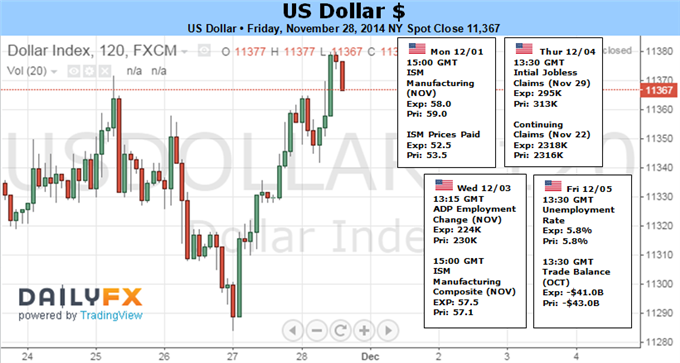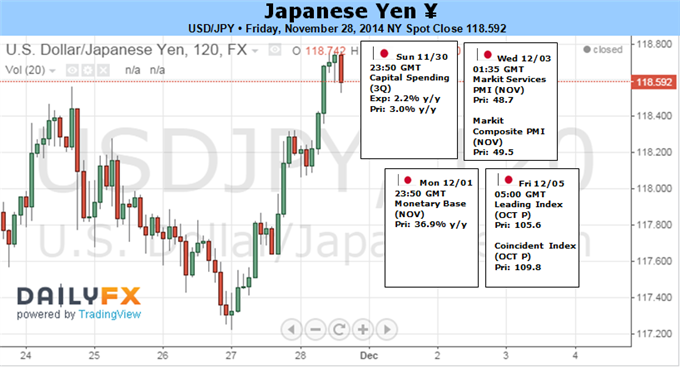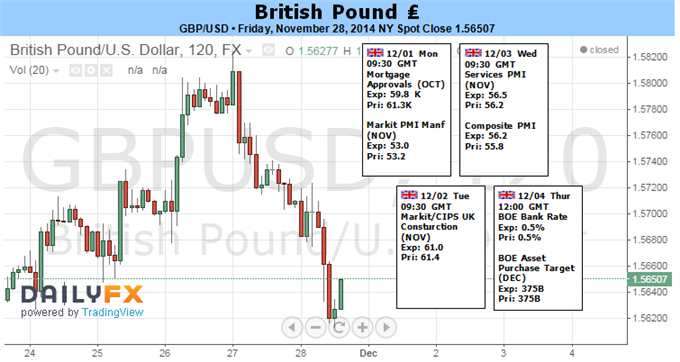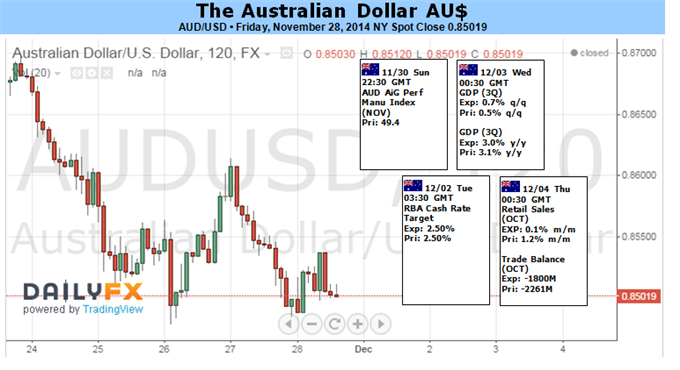Forex Weekly Outlook December 1-5
US ISM Manufacturing PMI, Rate decision in Australia, the UK and the Eurozone, Important employment events in Canada and the US including the important NFP release. These are Forex Market Movers This Week. Check out these events on our weekly outlook.
Last week, US data showed mixed results. Durable goods orders advanced unexpectedly 0.4% but missed on the core, posting 0.9% decline. Jobless claims disappointed crossing the 300,000 line for the first time in nearly three months with a 21,000 jump to 313,000. New Home Sales rose for the third straight month to a seasonally adjusted annual rate of 458,000 units but missed forecast for a higher gain of 471,000 units. Nevertheless, the second GDP release came out better than the first estimate, showing a 3.9% growth rate in the third quarter reflecting upward revisions to business and consumer spending, as well as to inventories. Due to the flood of US economic data released at once before Thanksgiving, volatility tends to be higher. Will the US data continue to show resilience?
- US ISM Manufacturing PMI: Monday, 15:00. US manufacturing PMI came in at 59.0 in October following 56.6 in the prior month. The release was higher than the 56.5 forecasted, contradicting the US manufacturing PMI from Markit Economics report showing manufacturing activity slowed to its lowest since July. Economists expect manufacturing PMI will reach 57.9 this time.
- Australian rate decision: Tuesday, 3:30. Australia’s central bank kept the cash rate at 2.5% in November, noting that rates will remain unchanged in the coming months and that currency remains overvalued. Governor Glenn Stevens has seeks to stimulate domestic growth drivers to boost economic growth. The RBA’s The growth outlook was less optimistic than in the previous report, but with diminished worries about the housing market. No change in rates is forecasted.
- Australia GDP: Wednesday, 0:30. The Australian economy expanded a seasonally-adjusted 0.5% in the second quarter after 1.1% growth registered in the first quarter. The release was better than the 0.4% rise forecasted by analysts. On an annual basis, GDP grew 3.1%, lower than the 3.4% recorded in Q1. Exports fell 0.9% compared to a 4.2% gain in the first quarter, while imports edged up to a 3.7% expansion from a 1.2% decline in the first quarter. Economists expect an annual growth of 3.0% in 2014, and a 2.8% gain in 2015. The third quarter GDP is predicted to be 0.7%.
- US ADP Non-Farm Employment Change: Wednesday, 13:15. The US labor market continued to strengthen in October, registering a pick-up of 230,000 in private sector hiring, after a 225,000 gain in the previous month. However the third quarter slowdown is expected to continue towards the end of 2014 which could badly affect the job market. A gain of 223,000 jobs is expected in November.
- Canadian rate decision: Wednesday: 15:00. Stephen Poloz head of the BOC decided to maintain borrowing costs due to sluggish growth of global economy. Poloz noted that rates could go up or down, depending on economic headwinds from the global economy. However, most economists expect the next rate move will be up, and that it will likely come by mid-2015. Overnight rate is expected to remain unchanged.
- US ISM Non-Manufacturing PMI: Wednesday: 15:00. US service-sector growth slowed in October to 57.1 from 58.6 in September. The index has been declining since July reaching its slowest pace of growth in 6 months. Nevertheless, the index is above 50 indicating growth. New business expanded in October, a good sign for economic growth. Employment remained strong, but business outlook was more pessimistic. US service-sector is expected to reach 57.5.
- UK rate decision: Thursday, 12:00. Bank of England voting members decided to keep interest rates at 0.5% in November. The stimulus program remained unchanged at £375 billion. Economists expected a rate hike in November, after Mark Carney, the Governor of the Bank of England noted the decision surrounding the timing of the first rate hike was “becoming more balanced” and “could happen sooner than markets expect”. The Official Bank Rate is predicted to remain unchanged this time.
- Eurozone rate decision: Thursday, 12:45. Mr. Draghi, the president of the European Central Bank, promised in October that more aggressive measures are being prepared, in the form of the large-scale bond purchases known as quantitative easing to boost growth in the Eurozone. The same promise was delivered in November with no substantial measures. Many economists expected real action in the form of the US QE. Even the Bank of Japan started its own QE program. Even though the Euro area economy is not in deflation, prices are falling constantly damaging companies’ revenues and raising unemployment. Real measures are expected on the December meeting.
- US Unemployment Claims: Thursday: 13:30. The number of Americans seeking U.S. unemployment benefits edged up to 313,000 last week, crossing the 300,000 line for the first time in nearly three months. The 21,000 jump beat forecasts for a 287,000 reading. The four-week average, a less volatile measure, rose 6,250 to 294,000. This sudden rise does not suggest a downturn trend, but is probably related to seasonal layoffs in sectors affected by the cold weather, such as construction. Economists expect US weekly unemployment claims to reach 297K
- Canadian employment data: Friday, 13:30. Canada’s job market unexpectedly increased by 43,100 positions in October, pushing unemployment rate down to a nearly six-year low of 6.5%. Analysts expected a contraction of 5,000 jobs following September’s gain of 74,100 positions. The jobless rate, declined from 6.8% in September, to the lowest since November 2008, suggesting the labor market is regaining strength. The labor participation rate, stayed at 66%, the lowest since November 2001. Full-time jobs increased by 26,500, while part-time positions increased by 16,500. Canada’s job market is expected to add 5,300 jobs while the unemployment rate is predicted to reach 6.6%.
- US Non-Farm Employment Change and Unemployment rate: Friday, 13:30. The US job market gained fewer than expected positions in October adding 214,000, but the Unemployment rate declined to its lowest level since 2008 reaching 5.8%. However, despite the forecast of 235,000 job addition, October’s gain is still considered positive. Wage growth remained sluggish, as wages increased 0.1% month-on-month, missing expectations for growth of 0.2%. Year-over-year, wages grew 2%, below expectations for a 2.1% gain. US job gain in November is expected to be 225,000, while the unemployment rate is predicted to remain unchanged at 5.8%.


 LinkBack URL
LinkBack URL About LinkBacks
About LinkBacks





 Reply With Quote
Reply With Quote






Bookmarks